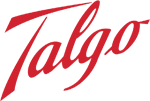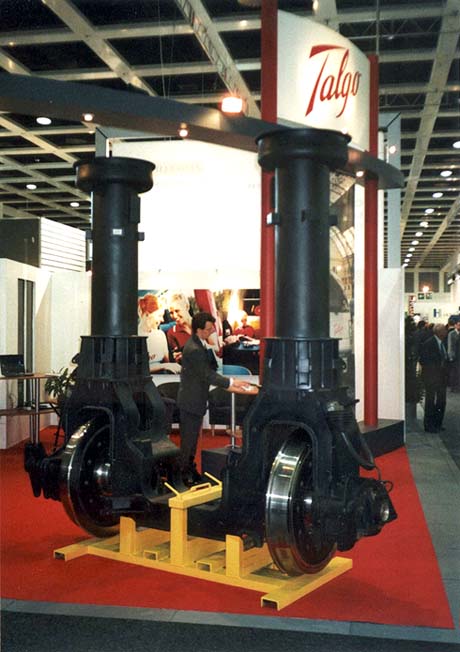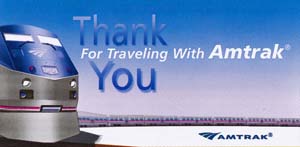 | 
To view the colour photos appearing with this article click on the camera above.
|
|
Amtrak Cascades

The evening northbound Amtrak Cascades at Stanwood, Washington, USA.
 Introduction Introduction
 Amtrak is an American federal government corporation officially known as the National Railroad Passenger Corporation offering intercity passenger train service in the United States. It employs nearly 19,000 people operating passenger service on 21,000 miles (34,000 km) of track primarily owned by freight railroads connecting 500 destinations in 46 states and three Canadian provinces.
The Amtrak Cascades is one of their trains run in conjunction with the states of Washington and Oregon between Vancouver, British Columbia, and as far south as Eugene, Oregon. The train is comprised of Talgo built passenger equipment pulled by conventional American built diesel-electric locomotives. The Cascade began service in 1993 with a single daily round trip between Seattle and Portland.
 Talgo History by Wikipedia Talgo History by Wikipedia
 Talgo is a Spanish manufacturer of railway vehicles but with an American manufacturing component. TALGO is the acronym for "Tren Articulado Ligero Goicoechea Oriol" or Train Articulated Light Goicoechea Oriol. Alejandro Goicoechea and Jose Luis Oriol being the founders of the company. Talgo patents were originally incorporated in 1942. Talgo is a Spanish manufacturer of railway vehicles but with an American manufacturing component. TALGO is the acronym for "Tren Articulado Ligero Goicoechea Oriol" or Train Articulated Light Goicoechea Oriol. Alejandro Goicoechea and Jose Luis Oriol being the founders of the company. Talgo patents were originally incorporated in 1942.
Talgo Pendular

Talgo is best known for a design of articulated railway passenger cars in which the wheels are mounted in pairs, but not joined by an axle, and set between, rather than underneath, the individual coaches. Another feature of the design is the suspension which allows the vehicle to passively tilt into curves, aiding passenger comfort.
The Talgo Pendular (Talgo IV, Talgo V, Talgo VI, and Talgo 200 or 6th generation), introduced in 1980, created the natural tilting train. A tilting train that does not need electronic sensors or hydraulic equipment to tilt the carriages.
The wheels are mounted on mono axles between the carriages. Sitting on top of these mono axles are suspension columns. The carriages are attached to the top of the suspension columns and swing outwards when the train travels round a curve, thereby giving the illusion to the passengers that the train is tilting into the curve.
Trial commercial services with Talgo cars in the United States commenced in 1994 between Seattle and Portland, and from 1998 different trains have been used on the Amtrak Cascades services between Vancouver, British Columbia, via Seattle, Washington, Portland, and Eugene, Oregon.
Early in 2010, the Oregon Department of Transportation announced that it had negotiated the purchase of two 13-car trainsets for use in the Pacific Northwest rail corridor between Eugene and Vancouver. These trainsets are to be manufactured in Wisconsin, and are slated to be delivered in 2012 - Wikipedia.
Talgo Train Renovations
Amtrak and the Washington State Department of Transportation (WSDOT) recently completed a major renovation on all the coach and business class Talgo cars used on the Cascades route. The renovation includes new exterior paint as well as upgrades to the cars interior. For instance, Amtrak has replaced coverings, surfaces, and decorative elements with more contemporary furnishings. And the seats have been replaced with fully reclining chairs upholstered in leather.
But not all the renovations are visible to the passengers. For example, the Talgo cars have been upgraded with safety and comfort features: - New floor structures to ensure that the seats remain secure in extreme situations;
- New emergency power supplies to provide lighting and communication in case of power failure;
- Low level exit path markers in the event of an emergency;
- Onboard industrial computers to manage operating data and support diagnostic systems;
- Amtrak also plans to implement a new GPS-based video information system, provide passengers with free Wi-Fi, and upgrade the bistro and dining cars.
 A Short Trip A Short Trip
 We took a short trip on Amtrak's Cascades train between Stanwood and Seattle, Washington for a day of sight seeing and shopping in the big city. The first southbound train out of Vancouver, British Columbia, was scheduled to arrive in Stanwood, Washington, station at 09:18. The day was overcast with light drizzle and a cold blowing wind. Stanwood is an un-manned depot with no shelter except for a couple of expensive stylish roofs which the rain ignores when the wind blows. Amtrak Cascades arrived an hour and ten minutes late. Cold and having had no breakfast we headed for the dining car hoping for a hot meal. Don't be fooled. The car is plainly labeled as a dining car on the exterior but there is no food service in the dining car. Onboard staff call it a "lounge". Next to this "lounge" is the Bistro car. Here you can purchase microwaved rubber food. If you wish you may then take it to the "lounge" for consumption. We took a short trip on Amtrak's Cascades train between Stanwood and Seattle, Washington for a day of sight seeing and shopping in the big city. The first southbound train out of Vancouver, British Columbia, was scheduled to arrive in Stanwood, Washington, station at 09:18. The day was overcast with light drizzle and a cold blowing wind. Stanwood is an un-manned depot with no shelter except for a couple of expensive stylish roofs which the rain ignores when the wind blows. Amtrak Cascades arrived an hour and ten minutes late. Cold and having had no breakfast we headed for the dining car hoping for a hot meal. Don't be fooled. The car is plainly labeled as a dining car on the exterior but there is no food service in the dining car. Onboard staff call it a "lounge". Next to this "lounge" is the Bistro car. Here you can purchase microwaved rubber food. If you wish you may then take it to the "lounge" for consumption.
SOUTH
| BOUND
| STATION
| NORTH
| BOUND
| Train 513
Time
| Train 517
Time
| Southbound read down
Northbound read up
| Train 510
Time
| Train 516
Time
| 06:40
08:35
09:05
09:18
10:02
10:27
11:05
| 17:45
19:40
20:12
20:25
20:59
21:24
22:10
| Depart Vancouver Arrive
Bellingham
Mount Vernon
Stanwood
Everett
Edmonds
Arrive Seattle Depart
| 11:40
09:49
09:18
09:03
08:31
08:07
07:40
| 22:50
20:58
20:29
20:14
19:42
19:17
18:50
|
About an hour and forty-five minutes later, and warmer, we were in better spirits as we pulled into King Street Station in Seattle. Somewhere on the World Wide Web there is a web site devoted to the renovation of this glorious station. One little corner of the station near King Street has been renovated and returned to the glory of its original construction. The work looks good and gives a hint of the possibilities to come. The gloomy main waiting room is another story however. Sometime many years ago this expansive space was fitted with a drop ceiling thereby lowering the height by at least half. Around the edges dirty ceiling panels have been removed so if you peer upwards into the dark interior above you can just make out some of the architectural embellishments that were left in place above the drop ceiling. Where the ornate columns drop down below the ceiling panels the ornate columns have been covered over, probably with wall board, so they are a simple box structure. In some places the columns are chiselled away leaving an ugly scar at the drop ceiling junction.
The station currently contains washrooms but there are no food vendors in situ.
One day, one day, maybe it will all be grand again, but there's a long road ahead.
At 18:50 our return journey departed Seattle heading north roughly on time. The weather had improved throughout the day so as the train wound along the western shore barely above sea level there were some stunning views of a sunset over the Pacific Ocean. Arriving in Stanwood the train cars were bathed in that warm yellow glow only a setting sun can provide.
Would I ride again? Maybe. That initial late train was a real uncomfortable annoyance. The delay was blamed on Customs but that doesn't excuse the wait or lack of communication advising there was a delay.
The next day, Thursday, 6 May 2010, I was in the Stanwood area photographing the train from trackside. That day it was just fifteen minutes late. Customs again?

 WSDOT FAC (Frequently Asked Questions) WSDOT FAC (Frequently Asked Questions)
What are Talgo trains?
What is pendular Talgo technology?
Why do we need these types of trains in the Pacific Northwest?
What train cars are included in a typical Amtrak Cascades train?
Where were the Amtrak Cascades trains built?
Are more Amtrak Cascades trains needed?
Do the Amtrak Cascades tail fins serve a purpose?
 News Articles News Articles
15 Apr 1999 - Amtrak Cascades Makes Tracks in Comfort and Style
20 Jun 2005 - King Street Station on Track to Return to...
25 Aug 2006 - Train Derails at Low Speed in Tacoma
20 Mar 2009 - Amtrak Cascades to Celebrate 10 Years of Service
9 Oct 2009 - Gov. Gregoire, Premier Campbell Celebrate 2nd...
23 Nov 2009 - Amtrak Trains Now Arriving at $5 Million Stanwood Station
3 Dec 2009 - Amtrak Cascades Renovations - First Look
26 Feb 2010 - ODOT Purchases Passenger Trains
16 Apr 2010 - Amtrak Cascades Starts 2010 with Record Ridership Growth
21 April 2010 - Amtrak Service to B.C. Will Continue Through September
18 May 2010 - DOT Improving Seattle-Portland Amtrak Service
 Bibliography Bibliography
Amtrak
Brian Soloman - 2004
160 pages - ? photos - ? drawings - ? maps - hardcover
8.6 x 10.7 inches - 22 x 27 centimetres
MBI Publishing
US$36.95
 This pictorial history is only the second of its kind to trace the 30-plus-year history of Amtrak, beginning with a look at the rise and fall of privately run passenger train service followed by a look at Amtrak's infant stage from 1971 through 1976. Also examined is the period from 1976 to 1991, when Amtrak finally established an image, buying new equipment, refurbishing old, and grew its ridership despite a severely limited budget. Modern and period color photos illustrate such aspects of Amtrak as its motive power, including the high-speed Acela Express, its diverse array of rolling stock and equipment, famous long-distance trains past and present, and short-haul corridors. The formation of Amtrak in 1971 heralded the end of privately operated passenger train service and ushered in an era of intercity train travel financed on a budget that has vacillated between the virtually non-existent and the barely adequate. This pictorial history is only the second of its kind to trace the 30-plus-year history of Amtrak, beginning with a look at the rise and fall of privately run passenger train service followed by a look at Amtrak's infant stage from 1971 through 1976. Also examined is the period from 1976 to 1991, when Amtrak finally established an image, buying new equipment, refurbishing old, and grew its ridership despite a severely limited budget. Modern and period color photos illustrate such aspects of Amtrak as its motive power, including the high-speed Acela Express, its diverse array of rolling stock and equipment, famous long-distance trains past and present, and short-haul corridors. The formation of Amtrak in 1971 heralded the end of privately operated passenger train service and ushered in an era of intercity train travel financed on a budget that has vacillated between the virtually non-existent and the barely adequate.
 Associated Web Sites Associated Web Sites
Amtrak
Amtrak Cascades
Talgo America
King Street Station
|




 This pictorial history is only the second of its kind to trace the 30-plus-year history of Amtrak, beginning with a look at the rise and fall of privately run passenger train service followed by a look at Amtrak's infant stage from 1971 through 1976. Also examined is the period from 1976 to 1991, when Amtrak finally established an image, buying new equipment, refurbishing old, and grew its ridership despite a severely limited budget. Modern and period color photos illustrate such aspects of Amtrak as its motive power, including the high-speed Acela Express, its diverse array of rolling stock and equipment, famous long-distance trains past and present, and short-haul corridors. The formation of Amtrak in 1971 heralded the end of privately operated passenger train service and ushered in an era of intercity train travel financed on a budget that has vacillated between the virtually non-existent and the barely adequate.
This pictorial history is only the second of its kind to trace the 30-plus-year history of Amtrak, beginning with a look at the rise and fall of privately run passenger train service followed by a look at Amtrak's infant stage from 1971 through 1976. Also examined is the period from 1976 to 1991, when Amtrak finally established an image, buying new equipment, refurbishing old, and grew its ridership despite a severely limited budget. Modern and period color photos illustrate such aspects of Amtrak as its motive power, including the high-speed Acela Express, its diverse array of rolling stock and equipment, famous long-distance trains past and present, and short-haul corridors. The formation of Amtrak in 1971 heralded the end of privately operated passenger train service and ushered in an era of intercity train travel financed on a budget that has vacillated between the virtually non-existent and the barely adequate.  Talgo is a Spanish manufacturer of railway vehicles but with an American manufacturing component. TALGO is the acronym for "Tren Articulado Ligero Goicoechea Oriol" or Train Articulated Light Goicoechea Oriol. Alejandro Goicoechea and Jose Luis Oriol being the founders of the company. Talgo patents were originally incorporated in 1942.
Talgo is a Spanish manufacturer of railway vehicles but with an American manufacturing component. TALGO is the acronym for "Tren Articulado Ligero Goicoechea Oriol" or Train Articulated Light Goicoechea Oriol. Alejandro Goicoechea and Jose Luis Oriol being the founders of the company. Talgo patents were originally incorporated in 1942. 
